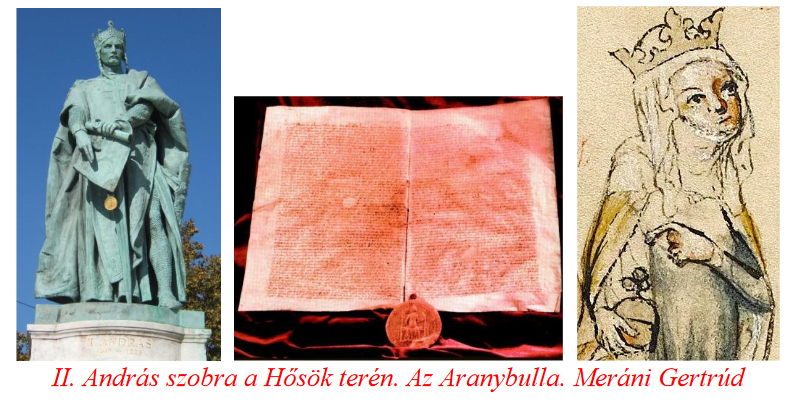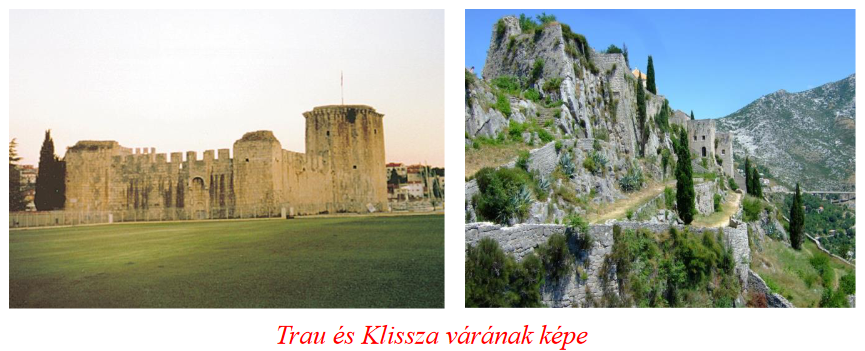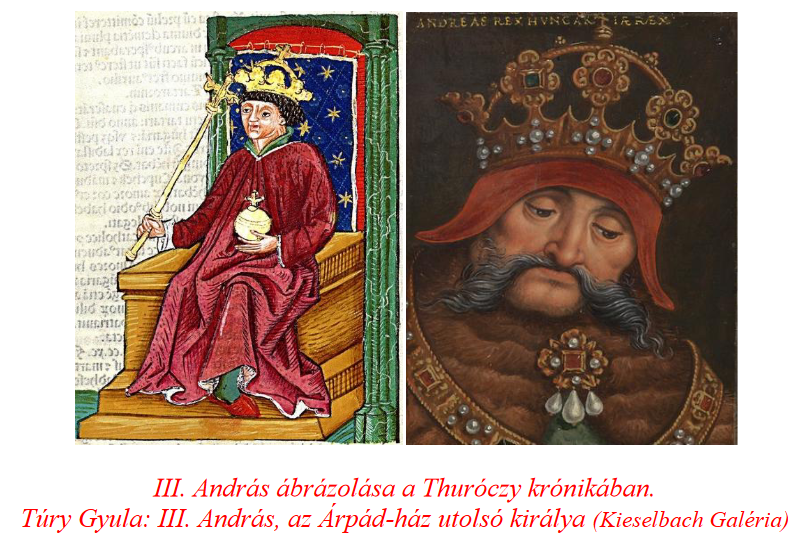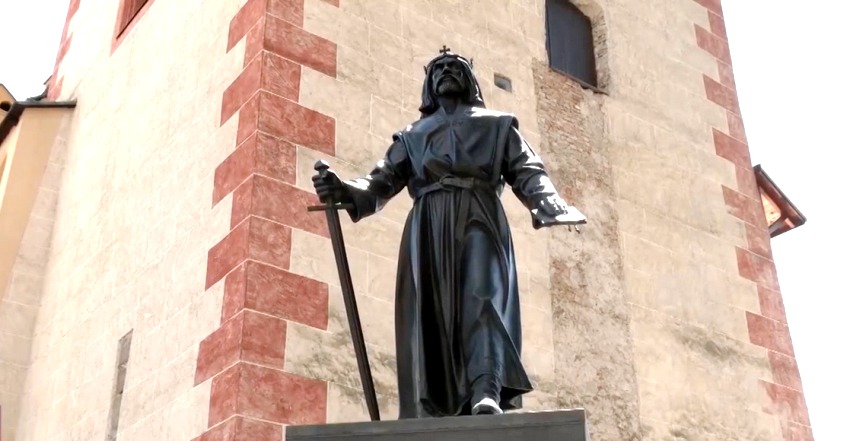"A nation that does not know its past does not understand its present, and cannot create its future!"
Europe needs Hungary... which has never let itself be defeated.
Hungarians in grades 9-10. century
by Álmos and Árpád . The discipline, fighting power, and consciousness of the Scythian peoples of the Hungarian tribes arriving from the eastern passes of the Carpathians were in harmony in Árpád's Hungarians. As long as this harmony, this unity, this war machine led by one leader existed, the Hungarians who recaptured the Carpathian Basin could not be defeated. A good example of this is the Battle of Brenta, which took place in 899, which, even if it took place in Northern Italy, could have been aimed, together with the other campaigns towards the west, of protecting the new homeland and establishing the independence of the Hungarian nation. defeated King Berengár, who was three times superior, The battle is still taught in many military academies today, as is the Battle of Bratislava in 907. In the latter, the 40,000-strong army led by Árpád destroyed the 100,000-strong German army coming to destroy the Hungarians. How could this be possible? There was a leader who knew what to do, the army was disciplined and determined, and they had combat experience. These and the other victories, wrongly called adventurous campaigns, eloquently proved that the Grand Duchy of Hungary had become a state equal to the European powers, which the Western leaders could never accept and accept us into Europe.

Hungary in the 11th century
King Vajk (István)' Koppány , his victory, and his accession to the throne, the unity of the Hungarians was broken. By accepting Christianity, by organizing the Kingdom of Hungary instead of the Principality of Hungary, and by asserting German-Bavarian interests, we were wedged into Europe, but it came at a price. Hungarian took up arms against Hungarian. Vazul's tragedy, his misrepresentation, and Prince Imre's unexpected death served foreign interests. However, let's not forget that when the brother-in-law of King István II. Henry died in 1024, the period of peace ended. The new German king, then Emperor II. Konrád (1024-1039) started his armies against the Kingdom of Hungary from 1030. However, King István inflicted a heavy defeat on the invaders, and even Vienna was occupied by the Hungarians. As a result of the peace concluded in 1031, the area between the Lajta and Fischa rivers also came into Hungarian hands. The Germans did not dare to attack our country while István was alive. Later, however, they resolutely continued the occupation of the Kingdom of Hungary.
István made it clear that he was the king of the Hungarians and did not yield to foreign interests. Not even when, unfortunately, he received many German powers and offices in his court. Against the Pope, he won the right for the Hungarian king of all times to have apostolic authority, the only one in Europe. This meant that in Hungary the king and not the pope could appoint the Hungarian ecclesiastical dignitaries, and the distribution of ecclesiastical estates was also exercised by the king.

After István's death, Péter Orseolo (1038-1041), born in Venice, came to the Hungarian throne. The bad ruler was driven out by the Hungarians and Aba Sámuel (1041-1044) was elected as their king. (He was the only elected and non-Árpád ruler.) Péter III. to Henrik , who of course was happy to help restore the ousted king to the Hungarian throne. Four German campaigns descended on our country, a series of bloody battles followed, until finally III. In 1045, Henry gave the Kingdom of Hungary to Péter at a ceremony in Fehérvár. I repeat. The German emperor gave Péter Orseolo the Kingdom of Hungary as a fief! Peter (1044-1046) became king for the second time, but continued where he left off. In the eyes of the Hungarians, the oath of fealty was considered open treason. The dispute over the throne continued, and the insurgents were led by Vata , the ispan of Pékés. Péter died of his injuries during the fighting. A new king was needed.

Bishop Gellért was on his way to receive the sons of Vazul, who had been called home, when he was attacked and killed by the insurgents. (Let's note, although this is a matter of debate, that Vazul's sons - András, Béla and Levente -, whom the Bavarian lords also wanted to kill, were fled from the country by István. This is how the Árpád house survived!)
The rebels elevated Vazul's eldest son, András, to the throne. (According to another assumption, András and his brothers László Szár .) András I (1046-1060) came home from Kiev and brought with him one of the daughters of Yaroszláv Bölcs Anastasia , who became his wife. During the 14-year reign of András, many noteworthy historical events took place. In 1051 in the Vértes Mountains and in 1052 near Bratislava on the Danube, the Hungarians dealt a heavy blow to the invading Germans. The military operations were led by Prince Béla, who was already as Béla Bajnok . The abbey was founded in Tihany in 1055, and the "crown or sword" scene took place in Várkony in 1059. Vazul's son was called András the Német , but András the Catholic . The previous adjective Henrik . His first-born son, Solomon IV. Henrik 's sister, Judit . The second son also received an Old Testament name when David . At the end of King András's reign, he did not appoint his younger brother, Béla, as they had agreed, but his son, Salamon, as his successor. This led to more wars, as Solomon was crowned king alongside his father in 1057.

Béla emerged victorious from the civil war of the Árpáds, who ruled as Béla I Béla was the king under whom the throne collapsed in Dömös, which was presumably an assassination by Solomon's Germans against Béla Bajnok. The wounded king still led his army against the emperor, but lost his life at Moson. Solomon was escorted by the Germans to Fehérvár, where, like his father András, he was crowned king as their vassal.
The fate of Vazul's sons was repeated when Béla's sons from Moson had to flee from the German armed men who were hunting them. Géza, László and Lampert also found refuge in Poland. However, the Árpád sons returned later and defeated Solomon in the battle of Mogyoród in 1074. The German troops could not help either in 1074 or 1079, Vazul's grandsons drove them out. Géza the throne , although he did not crown himself because Solomon was still alive. The gentle, kind-hearted Géza I (1074-1077) received the Magnus (noble-minded, great, powerful) from a subject.

ARC. Henrik continued to incite the fratricidal war. In the state of confusion, the Hungarians elected László as their king. Szent László came to power, one of the greatest in Hungarian history, and well-respected and well-known throughout Europe . The general who defends his country in every case and with all his might, the law-making king, and the ruler who reorganized the Hungarian Christian Church after Stephen. To this day, our people regard his actions as the glory and role model of our nation.

The reign of the seven kings of the 11th-century Kingdom of Hungary, fraught with throne disputes and fought against external enemies (Germans, Peschenis, Kuns, Croats), could even have ended with the extinction of the Árpád House. However, the two holy kings (István and László) put Hungary on such a solid foundation that it almost existed as an empire for five centuries.
 Fortunately, Saint László was succeeded by a strong-handed ruler who continued the country-building work of his great predecessor.
Fortunately, Saint László was succeeded by a strong-handed ruler who continued the country-building work of his great predecessor.
Those kings who stuck to their faith and ancient roots remained in power! Despite the internal strife and external attacks, the country kept its unity and territorial size!
Hungary in the 12th century
Although Kálmán Könyves (1095-1116), the successor of László, began in the 11th century, the work of one of the most educated rulers in Europe at the time dates back to the 12th century. During the time of Kálmán, Hungary was already considered one of the attractive regions of Europe. The 1.2 million Hungarian population was also increased by immigrants coming to the country from all directions. It was then that the first Jews and Ishmaelites arrived in our country, who primarily dealt with trade and finance. Relative calm prevailed in the country, the economy strengthened, and there were no bloody wars between the princes, as in the previous century. Following the southward expansion policy of Szent László, it is thanks to Kálmán that the Hungarian kings were also addressed as the King of Croatia until 1918. (It should be noted that since Saint Stephen, the Hungarians have not attacked foreign lands, their fight was always about defense and border protection. Saint László did not march into Croatia without reason either. When the Zvonimir , his widow - Ilona Árpádházi - turned against him He asked for the help of his brother King László against the Croatian lords. Saint László entered Croatia, thus beginning the centuries-long Hungarian-Croatian relationship.)
Béla Vak - the bloody showdown - must be mentioned. son of Kálmánt Könyves, II. István (1116-1131) succeeded him on the throne. However, the leader of the internal opposition, Kálmán's brother Álmos, could not accept this. Considering that at that time King László nominated him to the throne, and not Kálmán. The internal strife worsened, and when Álmos attacked Kálmán for the sixth time, the king took Álmos and his son, Béla, who was five years old at the time, and blinded them. (However, it should be known that Álmos turned to the German Emperor Henrik V for help.) II. István had no successor, so Álmos' son came to the throne, II. Béla (1131-1141). Béla Vak's wife, the vengeful Serbian Queen Ilona, persuaded Béla to execute Kálmán's followers. Keeping the diabolical plan a secret, Aradra convened a parliament.

After the bloody revenge II. Géza (1141-1162), III. István (1162-1171), meanwhile II. Viceroy László IV. István also played a role in Hungarian history. Ottó Freising visited Hungary , as well as a Moor and an Arab traveler, who admired the wealth of the country, the beauty of the landscape, the rich flora and fauna, and the cultivated lands. They reported on popular fairs, prosperous cities, and abundance.
This era was also not without events, but the golden age was brought to the throne by III. Béla (1172-1196) brought it. The prince, who grew up in Byzantium, was nicknamed the "Prince of the Golden City" after the bright city. King Béla created the permanent chancellery, recording all important things that happened in the country. (It should be known that there was a chancellery before, but it was not as well organized as in Béla III's court.) The king's court clerk was Anonymus , the famous chronicler /Gesta Hungarorum/. The treasury was full, the economic and cultural life was functioning at a high level, and Hungary's territory was the largest at that time. Our country III. During Béla's time, it became a country equal to the largest empires in Europe. In addition to rebuilding the Esztergom basilica, the king also founded several abbeys. In the Hungarian historical public consciousness, among the great kings of the Árpád family III. Béla is perhaps the only one who is not listed in accordance with his greatness, his actions, and the weight of his activities for the expansion of the country. But we have to rank it among the biggest.

Those kings who stuck to their faith and ancient roots remained in power! Despite the internal strife and external attacks, the country kept its unity and territorial size!
Hungary in the 13th century
Our compatriots who show little interest in history are also familiar with the concepts of the Golden Bull and the Second Founding Father, as well as II. András and IV. Béla the names of our kings. II. András (1205-1235) is primarily associated with the 1222 edition of the Golden Bull. The otherwise ambitious prince, III. Béla's younger son already rebelled against his older brother, King Imre (1196-1204), who was legally appointed by his father. In the meantime, he married the daughter of the Duke of Istria, Krajina and Meran, Gertrud . For one more year III. László (1204-1205) is the king who died as a small child. András (Endre) fulfills his father's final wish to lead a campaign to the Holy Land only belatedly. The campaign started in 1217, which consumed a huge amount of money and did not achieve its goal. On the way back, on the island of Malta, the Hungarian king was inaugurated as a member of the Knights of Jerusalem, from then on he could bear the name András of Jerusalem. In 1224, he settled the Saxons in Transylvania. This was Andreanum, which the Saxons then thanked by turning against the Hungarians almost every time.

Father and son - II. András and IV. Béla's battles against each other and for the security of the Carpathian basin did not weaken, but rather strengthened the country of the Árpáds. The 29-year-old Prince IV. Béla (1235-1270).
 King Béla's entire life was greatly influenced by the three women who were closest to him by blood. The first was his mother, who was murdered in Pilisszentkereszt in 1213, and had to watch a bloody event. The second sister of Béla, Erzsébet, born in Sárospatak, is one of the best-known figures in the Christian world. It can be assumed that after the Virgin Mary, Saint Elizabeth is the most revered female saint. The third woman, Margit , daughter of King Béla, is also a significant figure in Hungarian religious history.
King Béla's entire life was greatly influenced by the three women who were closest to him by blood. The first was his mother, who was murdered in Pilisszentkereszt in 1213, and had to watch a bloody event. The second sister of Béla, Erzsébet, born in Sárospatak, is one of the best-known figures in the Christian world. It can be assumed that after the Virgin Mary, Saint Elizabeth is the most revered female saint. The third woman, Margit , daughter of King Béla, is also a significant figure in Hungarian religious history.


ARC. In 1239, Béla stopped taking back land holdings. Later this year, he accepted the Kunians, which led to further internal strife. The chaos in domestic politics was exacerbated by the Mongol-Tatar threat, which had been known since 1236. The threat became a reality by the end of 1240. The Mongol conquerors reached the eastern border of the country. Friend Julianus , who with his fellow monks in II. He set out during the time of András, and in Magna Hungaria he found the Hungarians left in the east. At the same time, he brought the news that the conquerors were heading west. In April 1241, the Mongol army rushed to Hungary. (They were not Tatars.) IV. Béla fled west and then south with his family. In the meantime, Austrian Duke Frederick blackmailed the Hungarian king and took three counties from him.


Béla holed up in the castle of Trau (Trogir), which was still on the island at the time. He settled his family in the nearby castle of Klissza. The castles could not be captured by the pursuing Kadán troops.
In March 1242, the Mongol armies, which mercilessly destroyed the country, left the country in the direction of Havasalföld. It arises that if they won a decisive victory, if they yoked the whole country, then why did they withdraw so quickly and their work unfinished? A few comments that prove the strength of the Kingdom of Hungary.
Grand Khan Ögödej really died in 1241, but the election of a new Grand Khan took place only in 1246, in which Batu Khan did not even participate.
• The destruction of the Hungarians was not as significant as it was previously claimed. One and a half million did not die, "only" 400,000 people fell victim to the Mongol invasion. Of course, that's a lot! Our ancestors saved the western half of Europe from the Mongol invasion in the middle of the 13th century, neither for the first time nor for the last time.
• King Béla, the second founder of the country, was able to revive the rest of the population in a relatively short time, and was able to put the country's reconstruction on new foundations. From this, we can conclude that there were workers and life force in Hungary.
• The Mongol army retreated not only for tactical reasons. Among other things, because in addition to the Hungarians, the neighboring Christian states also showed strong resistance, which broke Batu Khan's strength and momentum.
• At Muhi, only a part of the Hungarian force appeared. After all, after the Mongol campaign IV. Béla led several campaigns abroad within a short period of time. First, he took back the three western counties that had been fraudulently stolen from Frederick of Austria.
• In 1243, Venice annexed Zára again, taking advantage of Hungary's difficult situation. The calamari who professed to be Christians did not deny themselves. For them, the economic advantage was more important than the security of the region. In addition, in the summer of 1243 locusts and famine ravaged the country, which hindered construction.
• In addition to the nobles, commoners also opposed the Mongol conquerors. Batu Khan had a lot of trouble in providing for his troops scattered throughout the country and organizing supplies. (It should be noted here that on April 5, 1242, the Russians won a decisive victory over the Teutonic Knights at Lake Csúd, and thus were able to line up their forces against the Mongols and Tatars.)
• In the winter of 1241/42, the weather was unusually cold and rainy. In the spring, the troops could not advance due to the great mud, as the Hungarian plain turned into a sea of swamps. There was no harvest, so neither the horses nor the conquerors had access to food. The step weather lasted until 1244.
• We know that in the winter of 1242 Fehérvár, Esztergom, Visegrád, Győr, Veszprém, Tihany, Moson, Pannonhalma, Sopron, Vasvár, Zala, Léka, Újhely, Nyitra, Bratislava, Komárom, Fülek, Abaújvár remained in the hands of the Hungarians. In addition to these, the nomadic conquerors could not take another hundred and sixty castles, monasteries, towns, and fortresses. Thanks to the stable foundations of the country, the Carpathian Basin has gained new strength. The Mongol invasion did only as much harm to the Kingdom of Hungary as the loss of the Battle of Augsburg in 955 did to the Principality of Hungary. It did not shake its foundations, but rather strengthened Hungary.
From the Mongol invasion to the extinction of the Árpád house (1241 – 1301)
The second half of the 13th century was associated with the heroic tasks of rebuilding the country, the lion's share of which was carried out by King IV. Béla undertook and completed it. The royal family returned home to Hungary and immediately went to work. The guiding thought that guided Béla was to radically change his previous methods. The construction of stone castles, the setting up of a new armed army, the transformation of the taxation system and property policy in the interest of the country brought success. The proportion of private castles rose to over 60% in three decades.


ARC. Béla prepared for another attack, which happened. (During the second major attack that also affected Hungary in 1258, the Tatars actually attacked our country.)

The construction of Buda Castle began in 1243 on "Újhegy in Pest". Most of the population of Pest was moved to Várhegy. The protective fortress was completed in 1255. It was also the duty of the cities and the owners to display the heavy cavalry. In addition to what was described above, one of the king's most significant actions was the resettlement of the previously expelled Kunis.
In addition to new alliances, military and economic endeavors, IV. Béla went through a change that few people have seen. The second founder of the country achieved the flourishing of the country's economy, for example, by renewing the privileges of the settlers (hospes) of Zólyom, Körmend, Corpona and Pest, and by expanding the rights of the nobles of Szepi. In 1245, in accordance with the previous practice of the Árpád house, IV. Béla crowned his son, Prince István. In 1246, Frigyes Babenberg (Harcias) attacked Hungary again to recapture the Hungarian territories stolen in 1241 - which King Béla had already taken back in 1242. However, Frigyes fell in the battle along the Lajta (at Bécsujhely). He had no successor, thus the Babenberg house, which ruled Austria, became extinct. One of the great contradictions of history is that the Habsburgs, who succeeded the Babenbergs, came to power with the help of the Hungarians. Ten years after the Mongol invasion, the economic life of the country flourished, the Hungarian people built castles, villages, churches, and monasteries at a rapid pace with the support of the hospes. In these years, the first gold and silver mines were discovered, which brought about the spread of financial management. It should be emphasized that in 1255 IV. Béla donated the proceeds of the Buda fair to the nuns of Margitsziget. He nominated his son, Prince István, as his successor.

 Prince István exercised his sovereign rights as early as the 1260s, and was then turned against his father by the opposition lords. II was repeated. András and Prince Béla's tension with each other decades earlier. The results of economic and political life were weakened by internal conflicts as well as foreign wars. István scattered the money, shared power with the barons, gifted the royal estates indiscriminately, and accumulated positions in order to win over the lords. A competition started between the lords to see who could build a stronger, bigger castle. Anyone who fell behind in this was reduced to the level of a vassal (servant of a greater lord). It was then that the system of familiarity was formed in our country.
Prince István exercised his sovereign rights as early as the 1260s, and was then turned against his father by the opposition lords. II was repeated. András and Prince Béla's tension with each other decades earlier. The results of economic and political life were weakened by internal conflicts as well as foreign wars. István scattered the money, shared power with the barons, gifted the royal estates indiscriminately, and accumulated positions in order to win over the lords. A competition started between the lords to see who could build a stronger, bigger castle. Anyone who fell behind in this was reduced to the level of a vassal (servant of a greater lord). It was then that the system of familiarity was formed in our country.
Subordination and subordination in Hungary, as the name implies, resulted in a system with a family structure. In contrast to the western feudal lord system, in which the differences in wealth (land holdings) appeared in a much harsher way between noble and noble, not to mention the serfs who were in a completely vulnerable position. At that time, serfdom as such did not exist in Hungary. In 1267, the king issued a law at the national assembly in Esztergom, confirming the Golden Bull, which gave rank and security to the serviants against the barons.
For the sake of completeness, it should be noted that the noble families with enormous estates - the Csák, Aba, Kán, Kőszegi, Borsa - were formed in these years, which then became IV. After Béla's death, they were already in opposition to the central power. (Our historiography mentions them as little kings.) An armed struggle broke out between Béla and István, who also ruled Transylvania. The decisive battle took place in 1265, at Isaszeg. After that, they made peace, but the tension between father and son remained. Béla's family on his deathbed II. Ottokár recommended him for protection. One of the famous rulers of Hungarian history, the second founder of the country, died of natural causes in 1270 at the age of 64. (This was considered unusual, because few of the 23 Árpád kings died of natural causes.)

After the king's death, civil strife broke out during the reign of István V However, István died under unclear circumstances at the age of 33. All this happened when his minor son, László, was kidnapped. He tracked down the robbers, and that's when he met his end.
After the death of István V, László came to the throne IV. László (1272-1290). László's mother Szejhán Kun Erzsébet , whose sixth child the heir to the throne was. The life path of the penultimate Árpád house king and his often unusual actions were also determined by his origin. But not because of his origin, but rather because of his policy of supporting the Kunas, he was already given the László Kun .

One of the great contradictions of Hungarian history is that László Kun, in the decisive second Moravian (Dürnkrut) battle of 1278 II. He took up arms against Ottokár. There was also a domestic political reason for the decision, as Henrik Kőszegi , the lord of the western parts of the country, entered into an alliance with Ottokar. Rudolf Habsburg , who was at the head of an almost insignificant and unknown army of only 2,000 men . The Kun-Hungarian-Székely-Beshen army led by King László, with his Austrian ally on his side, won a victory over nearly 30,000 Czech and German troops. Ottokár himself fell in the battle. The rise of the Habsburg family began with this event.
 László Kun's double life was ended by a party in the camp next to the Körzöz castle. King László was secretly assassinated on one night in the summer of 1290 by three Kuns' confidants, Árboc, Törtel and Kemence.
László Kun's double life was ended by a party in the camp next to the Körzöz castle. King László was secretly assassinated on one night in the summer of 1290 by three Kuns' confidants, Árboc, Törtel and Kemence.

II. Endre died, his wife Beatrix had to flee the court. On the way, she gave birth to her son, István, on German soil. The adventurous young man married Tomasina Morosini

The young king was also supported by the two most powerful lords, Máté Csák and Henrik Kőszegi , which gave András faith and hope. In the 1290s, the country was at its lowest point. At the National Assembly held in Óbuda, important but difficult to implement agenda items were created. Even then, the greatest danger was posed by the Habsburgs. The Hungarian-Austrian war, which neither side really had an interest in, ended with the Peace of Hainburg after a few minor skirmishes. The Hungarian king recovered the western castles and estates that had previously fallen into Austrian hands, most of which belonged to the Kőszeg family. However, the powerful family - and the other barons - did not implement the royal decisions, and thus the country descended into anarchy again.

As paladin István Ákos put it, "András, the illustrious king of Hungary, has died, the last golden branch that sprung from the lineage, tribe and blood of King Saint István, the first king of the Hungarians, on his father's side." After the king's death, the fight for the throne began immediately, which caused one of the most serious crises in Hungarian history. All this happened in 1301.
For the sake of historical interest, I note that Péter Orseolo and III. András - the beginning and the end - both came from Venice.

The conquering dynasty never called itself the House of Árpád, they actually considered themselves the Turul clan. Most of the peoples of Europe called this country pagan, foreign, barbarian for centuries. The greatest significance of the Árpáds' reign was that the continuous attacks from the east, south and west could never break the independence and self-reliance of the people of the Carpathian Basin. The ruling dynasty of the so-called pagan country produced the most saints among all European ruling families, and what's more, the Hungarian kings had apostolic power. Western nations were always ready to look down on and condemn the Hungarians, but the Hungarians were good at helping, acting as a shield, and strengthening family ties.
Those kings who stuck to their faith and ancient roots remained in power! Despite the internal strife and external attacks, the country kept its unity and territorial size!
Author: Ferenc Bánhegyi
Cover image:
The parts of the series published so far can be read here:1., 2., 3., 4., 5., 6., 7., 8., 9., 10., 11., 12., 13., 14., 15., 16., 17., 18., 19., 20., 21., 22., 23., 24,, 25., 26., 27., 28., 29/1.,29/2., 30., 31., 32., 33., 34., 35., 36., 37., 38., 39., 40., 41., 42., 43., 44., 45., 46., 47., 48., 49., 50., 51., 52., 53., 54., 55., 56., 57., 58., 59., 60., 61., 62.












